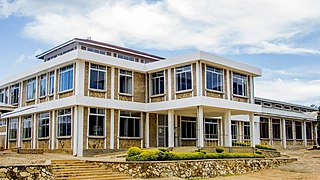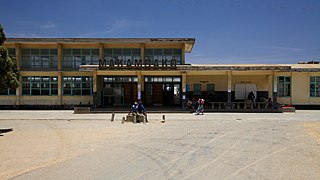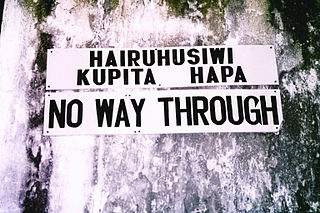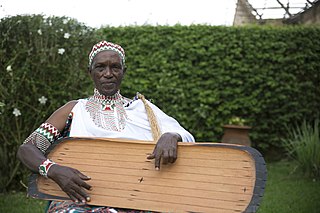
Iringa is a city in Tanzania with a population of 202,490 and situated at a latitude of 7.77°S and longitude of 35.69°E. The name is derived from the Hehe word lilinga, meaning fort. Iringa is the administrative capital of Iringa Region. Iringa Municipal Council is the administrative designation of the Municipality of Iringa. Iringa has been one of the coldest regions in Tanzania due to its geographical location but that has attracted a lot of tourists from colder regions abroad especially Western Europe. Iringa also hosts one of Africa’s largest national parks the Ruaha National Park.

Chief Mkwavinyika Munyigumba Mwamuyinga, more commonly known as Chief Mkwawa or Sultan Mkwawa, was a Hehe tribal leader in German East Africa, based in Kalenga, Iringa region, who opposed the German colonization. The name "Mkwawa" is derived from Mukwava, a shortened form of Mukwavinyika, meaning "conqueror of many lands".

The Nyamwezi are one of the Bantu groups of East Africa. They are the second-largest ethnic group in Tanzania. The Nyamwezi people's ancestral homeland is in parts of Tabora Region, Singida Region, Shinyanga Region and Katavi Region. The term Nyamwezi is of Swahili origin, and translates as "people of the moon" or "people of the west", the latter being more meaningful to the context.
The Nyakyusa are a Bantu ethnolinguistic group who live in the fertile mountains of southern Mbeya Region of Tanzania and the Northern Region of Malawi. They speak the Nyakyusa language, a member of the Bantu language family. In 1993 the Nyakyusa population was estimated to number 1,050,000, with 750,000 living in Tanzania. Nyakyusa are marked as highly educated and eager agriculturists. The Nyakyusa are colonising people where success and survival depended on individual effort. Nyakyusa have managed to collect vast wealth from trade and agriculture than any tribe in Tanzania..

Iringa Region is one of Tanzania's 31 administrative regions. The region covers an area of 35,503 km2 (13,708 sq mi). The region is comparable in size to the combined land area of the nation state of Guinea Bissau. Iringa Region is bordered to the east by Morogoro Region and south by Njombe Region. On the west the region is bordered by Mbeya Region. Dodoma Region and Singida Region border Iringa on the north. The regional capital is the city Iringa for which the city is named after. According to the 2022 census, the region has a total population of 1,192,728. Iringa Region is home to Ruaha National Park, Tanzania's second national largest park.
Gogo is a Bantu language spoken by the Gogo people of Dodoma Region in Tanzania. The language is spoken throughout Dodoma Region and into the neighbouring district of Manyoni.

The Sandawe are an indigenous ethnic group of Southeast Africa, based in the Chemba District kwamtoro ward of Dodoma Region in central Tanzania. In 2000, the Sandawe population was estimated to be 40,000.
The Safwa are an ethnic and linguistic group based in the mountains of the Mbeya Region, Tanzania. The Safwa language is a member of the large Niger–Congo language family group. Alternate names for Safwa are Ishisafwa, Cisafwa, and Kisafwa. Its dialects are Guruka, Mbwila, Poroto, and Songwe. ISO 639-3 language code is sbk.
The Ndamba are an ethnic and linguistic group based in south-central Tanzania whose population was 500,000 in 2022. They are found in everywhere in Tanzania especially south central, the Kilolo District of Iringa Region, northeast of Bena, southeast of Hehe, west of Pogolo and southwest of Mbunga.

The Kinga are an ethnic and linguistic group native to Mbeya Region and Makete District of Njombe Region, Tanzania, in the great Kipengere Range northeast of Lake Malawi. In 2003 the Kinga population was estimated to number 140,000.

The Hehe is a Bantu ethnolinguistic group based in Iringa Region in south-central Tanzania, speaking the Bantu Hehe language. In 2006, the Hehe population was estimated at 805,000, up from the just over 250,000 recorded in the 1957 census when they were the eighth largest tribe in Tanganyika. There were an additional 4,023 of them in Uganda in 2014.
Igurusi is an administrative ward in the Mbarali district of the Mbeya Region of Tanzania. In 2022 the Tanzania National Bureau of Statistics report there were more than 28,000 people in the ward, from 24,573 in 2016.
Hehe, also known by its native name Kihehe, is a Bantu language that is spoken by the Hehe people of the Iringa region of Tanzania, lying south of the Great Ruaha River. It was reported to have "Ngoni" features, that is, words of a Zulu-like language introduced when conquered by a Nguni or Zulu-like people in the early 19th century. However, other "Ngoni" speeches seem to have lost most of these distinctive features over the past 150-odd years, the language more resembling those of the neighbouring peoples. In the 1970s, it was estimated that 190,000 people spoke Hehe. There has been some Bible translation. Hehe may be mutually intelligible with Bena.

Makambako is a medium-sized town and district in the Njombe Region of the Tanzanian Southern Highlands, located roughly 40 miles north of Njombe city by road. It is located at junction of the A104 and B4 roads between Njombe, Iringa, and Mbeya. Its population according to the 2002 Tanzanian census was 51,049.

Tanzania is a multilingual country. There are many languages spoken in the country, none of which is spoken natively by a majority or a large plurality of the population. Swahili and English, the latter of which was inherited from colonial rule, are widely spoken as lingua francas. They serve as working languages in the country, with Swahili being the official national language. There are more speakers of Swahili than of English in Tanzania.

Njombe Region is one of Tanzania's 31 administrative regions which covers a land area of 21,347 km2 (8,242 sq mi). The region is comparable in size to the combined land area of the nation state of El Salvador. Njombe Region is bordered to the north by the Iringa Region and Mbeya Region, to the east by Morogoro Region, to the south by the Ruvuma Region and to the west by Lake Nyasa. The regional capital is the municipality of Njombe. According to the 2012 national census, the region had a population of 702,097.

Tom von Prince was a military officer and plantation owner in German East Africa. He most notably, as a captain in the Schutztruppe, led the first action by German forces in East Africa during World War I by seizing Taveta on 15 August 1914, and was then killed in November at the Battle of Tanga.

Trough zithers are a group of African stringed instruments or chordophones whose members resemble wooden bowls, pans, platters, or shallow gutters with strings stretched across the opening. A type of zither, the instruments may be quiet, depending upon the shape of the bowl or string-holder. Sound is often amplified with the addition of a gourd resonator. Instruments have been classed into five different types, based on shape.

Emil von Zelewski was a German officer of Kashubian descent who served as commander of the Schutztruppe in German East Africa. He led German forces against an uprising by the Hehe people, and was killed at the Battle of Lugalo.

The Mlambalasi Rock Shelter is a historic site located in Iringa District of Iringa Region in southern Tanzania, 50 km away from Iringa City. Excavations in 2006 and 2010 by the Iringa Region Archaeological Project uncovered artifactual deposits from the Later Stone Age (LSA), the Iron Age, and the historic periods, as well as external artifacts from the Middle Stone Age (MSA). Direct dating on Achatina shell and ostrich eggshell beads indicates that the oldest human burials at Mlambalasi are from the terminal Pleistocene. Mlambalasi is characterized by interment in the LSA and Iron Age periods, as well as by cycles of use and abandonment.













